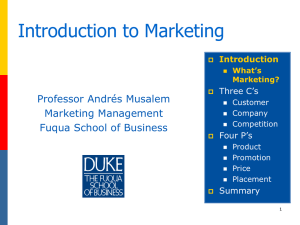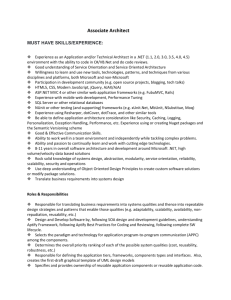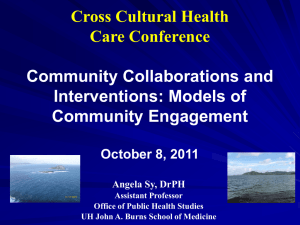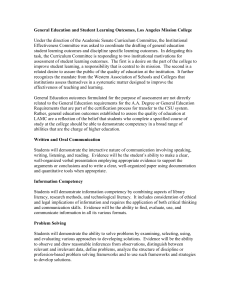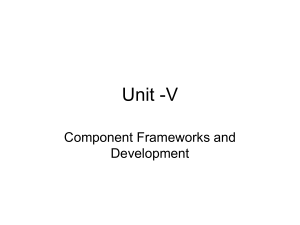Middle School Projects - Mississippi Space Grant Consortium
advertisement
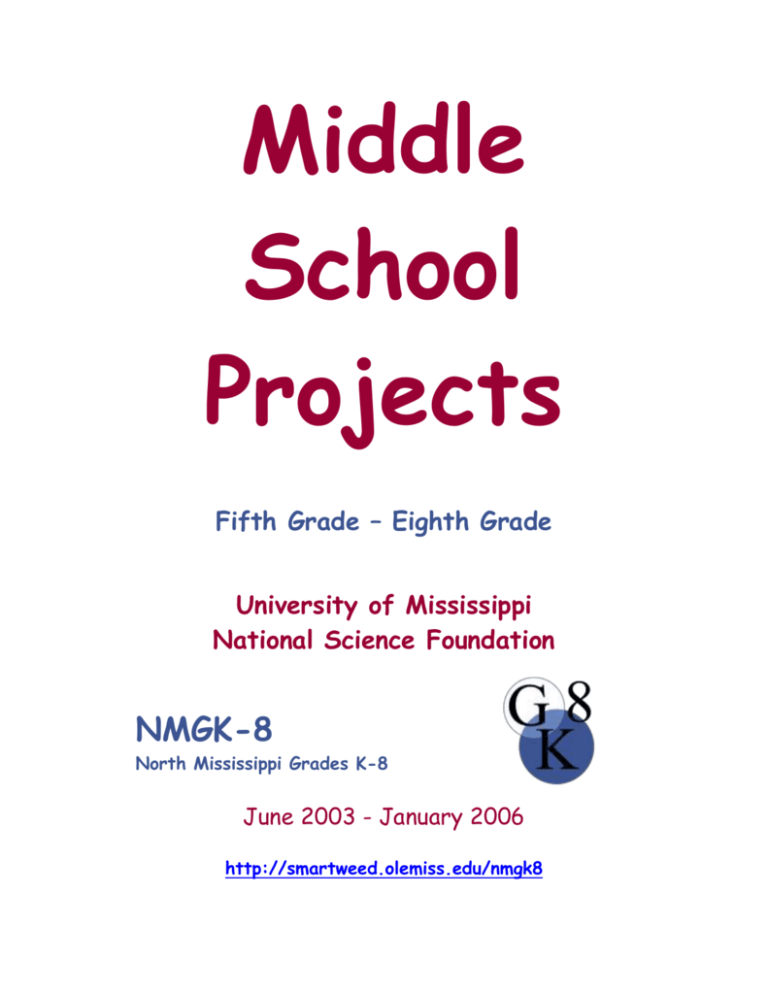
Middle School Projects Fifth Grade – Eighth Grade University of Mississippi National Science Foundation NMGK-8 North Mississippi Grades K-8 June 2003 - January 2006 http://smartweed.olemiss.edu/nmgk8 Fifth Grade Creating a PowerPoint Presentation This is a lesson that outlines the steps for creating a Microsoft PowerPoint presentation. The presentation format is PowerPoint with the goal of instructing students in creating their own presentations. A sample PowerPoint slide show about the Mississippi River is included in this project. Math Frameworks: 3b, 3c, 3d Crime Scene Insects This project will introduce students to the three main parts of an insect, stages of insect development, and provide means for identifying insects associated with crime scenes. Math Frameworks: 2a, 2b, 2c, 2d, 2e, 4a Science Frameworks: 4a, 5a, 5b Design a Phytoplankter This experiment introduces students to phytoplankton and allows the students to measure and compare sinking rates based on shape differences. Science Frameworks: 4a, 4b, 5a, 5b, 8a, 9b Egypt from a Math and Science Perspective This project contains multi-disciplinary activities on Ancient Egypt and a comparison of the Mississippi River vs. the Nile River from a math and science perspective. Math Frameworks: 1b, 1d, 1e, 1g, 2a, 2c, 3b, 3c, 3d, 4g Science Frameworks: 3a, 3b, 5a, 5b, 8a, 8b, 8d Famous Greek Mathematicians This project was designed to show students some accomplishments of famous Greek mathematicians. Among the mathematicians discussed are Pythagoras, Zeno, Archimedes, and Eratosthenes. Math Frameworks: 1c, 2c, 4d Science Frameworks: 9b Forces and Motion This is a design project involving the design, construction, and racing of rubber band cars to explore the motion of objects and the effects of forces. Science Frameworks: 9a, 9b How to Build an Ecosystem This activity-based project includes building two different ecosystems. A desert ecosystem and a rainforest ecosystem are constructed by the students. The students record their observations over time. Science Frameworks: 1b Mars This project includes a series of activities based on a hypothetical trip to Planet Mars. Math Frameworks: 2c, 2d, 4e Science Frameworks: 4b, 5b Oobleck This project includes a discussion of water pollution intended to increase awareness regarding appropriate and inappropriate methods for disposing of oil, and an activity emphasizing measurement and proportions. Math Frameworks: 2b, 2d The Rebels Measure Up This project is designed to enhance estimation skills and as a consequence measuring, perimeter, and area will be discussed. Math Frameworks: 1b, 1c, 2e, 5i, 5k Two Systems of Measurement This activity-based project is designed to help students develop an understanding of the metric system and understand the relationship between the English and metric Systems. Math Frameworks: 2a, 2b, 2c, 2d, 2e Zooconomics This project is an introduction to basic economic principles through the designing and placement of a zoo. Math Frameworks: 1b, 2b, 2c, 5f Sixth Grade Design a Phytoplankter This experiment introduces students to phytoplankton and allows the students to measure and compare sinking rates based on shape differences. Science Frameworks: 4a, 4b Earth From Space This activity tests the student's knowledge and recognition of different geographic places around the world. There are several satellite images taken of different places, such as the Grand Canyon, San Francisco Bay , and the Eiffel Tower . Students try to identify the location. Science Frameworks: 3a Famous Greek Mathematicians This project was designed to show students some accomplishments of famous Greek mathematicians. Among the mathematicians discussed are Pythagoras, Zeno, Archimedes, and Eratosthenes. Science Frameworks: 3a, 10c Measure to Treasure This is a classroom and outdoor activity designed to improve skills in measurement by using both English and metric units. Students will measure random classroom objects to familiarize themselves with measurement and the tools of measurement. Then, they will use a compass in an outdoor setting to follow a set of directions (directions of length and direction) in order to find a buried treasure (X marks the spot). Math Frameworks: 4b, 4c, 4e Metamorphic Rock Activity This activity-based project demonstrates how metamorphic rocks are formed. The students will use chocolate chips, peanut butter chips, white chocolate chips and M&M's to create a metamorphic chocolate rock. Science Frameworks: 6b Reduce Your Trash: A Project on the 3R's A series of activities demonstrating the importance of reducing, reusing, and recycling consumer goods. Math Frameworks: 3b, 3c, 3d, 4c, 4e, 6c, 8a Rock Lab This hands on activity will help students get familiar with the three different types of rocks. Science Frameworks: 6b Seeds This activity will introduce the concept of seeds to students through classroom activities and presentations. Science Frameworks: 2a The Bug Files An activity that allows students use a dichotomous key to identify insects. Science Frameworks: 2b, 3b The First Bank of the United States This project is a folder of information on the creation of the First Bank of the United States, how it worked, why it failed, and other relevant topics. A math activity is included to help the students understand why using money is better method than bartering. Math Frameworks: 8a, 8b, 8c The Rebels Measure Up This project is designed to enhance estimation skills and as a consequence measuring, perimeter, and area will be discussed. Math Frameworks: 3a Two Systems of Measurement This activity-based project is designed to help students develop an understanding of the metric system and understand the relationship between the English and metric Systems. Math Frameworks: 4a, 4b, 4c, 4d, 4e Volcano Activities and Presentation This project consists of a PowerPoint presentation covering all the basics on volcanoes and volcanic activity. The accompanying activity consists of creating gelatin volcanoes, injecting them with red food coloring in order to simulate the formation of dikes, and observation and interpretation of the results. Science Frameworks: 6b Water Quality This project includes instruction, demonstration, and lab activities for the students to participate in a series of tests used to determine the health of a water system. The tests include chemical assays (LaMotte kit), biological indicators, and physical testing. The goal of the project is for the students to understand how to interpret the results and make a conclusion about the health of the water system. Math Frameworks: 4b, 4d Science Frameworks: 3a, 3b, 5a What's in a Name? Taxonomy and Species Identification This is an activity on the modern system of classifying plants and animals including the structure of the taxonomical system. Students learn the defining characteristics of each of the five kingdoms through a "Taxonomy Rummy" card game, then use a dichotomous key to identify plant species in the wild. Science Frameworks: 5 Seventh Grade A Guide to Creating a Mississippi River Presentation This presentation guides students in their research by offering sample topics and questions about the Mississippi River and provides presentation tips when using PowerPoint. Science Frameworks: 4c, 6e A Look into America's Weather This project will provide the students with a “hands on” activity to understand changes in weather. A review of possible career choices in the field will be included, along with how weather affects our surroundings. Science Frameworks: 6g, 7e Balancing Equations An activity demonstrating that solving linear equations is a balancing act. This done by using a triple beam balance and letting unknown weights be the variables in a linear equation. Math Frameworks: 7b, 7c, 8b Budgeting Down the Mississippi River This activity includes guidance for students to develop a budget as they travel down the Mississippi River for one simulated weekend. Students must consider travel, food, lodging, and other costs for each day of their trip. Math Frameworks: 4a, 4g, 8d, 8f Constructing 3-Dimensional Figures This is an activity-based project designed to help students recognize specific 3-dimensional figures as well as the spatial orientation of them. Constructing these figures is done with molecule modeling sets. Math Frameworks: 5i Design a Phytoplankter This experiment introduces students to phytoplankton and allows the students to measure and compare sinking rates based on shape differences. Math Frameworks: 3a, 4b, 4e Science Frameworks: 4d Earthquake Activities This project includes several activities and a PowerPoint presentation on earthquakes. The activities include: 1. What liquefaction is and how it occurs, 2. How a seismometer works and how to construct one, 3. Demonstration on how earthquake waves travel. Science Frameworks: 6b Endangered Species This project consists of multiple activities and a collection of information about endangered species including designing and constructing a model zoo. Science Frameworks: 4, 4c, 5, 5c Erosion and Weathering Activities This project consists of erosion and weathering activities in five stations that demonstrate various forms of erosion and weathering, including particle size; erosion in a river, detailing the relationship between sand, gravel, and angle of tilt; chemical reactions in rocks and minerals; and air content of soil. Science Frameworks: 6c, 6d, 8 Forensics and DNA Analysis This project is designed to introduce the students to the concepts of forensics science and DNA restriction analysis. The students will use gel electrophoresis to investigate a simulated crime. Math Frameworks: 3a, 3c Science Frameworks: 2a Fractals This project is designed to show students what a fractal is, some mathematics behind fractals, and where fractals can be found in art, nature, and technology. Math Frameworks: 5e, 5f Fundamentals of Geometry with Geometer Sketchpad This project is a short introduction to Geometer's Sketchpad (tools and functions) as well as information on the geometric properties of triangles and squares. Math Frameworks: 5b, 5c, 5d Grain Size Analysis This project is a hands-on activity to get the students familiar with soil in which they collect soil and take field notes. They learn what soil is and how to distinguish between the different grain sizes. Additionally the students learn engineering properties and applications of each soil type. Math Frameworks: 4b, 8d, 8e It's All in the Genes Students will analyze the total finger ridge patterns (TRC)in class to determine whether it follows a typical binomial distribution, which is a characteristic of traits controlled by the additive effect of many genes (polygenic inheritance). Also, students will study basic DNA structure and gene regulation. Math Frameworks: 4b, 4e Science Frameworks: 2a It's Easy As 1, 2, 3.... This project introduces the scientific method through the determination of density and specific gravity. Math Frameworks: 1a, 1b, 3a, 3c, 8f Science Frameworks: 8e Lab Safety This project describes several major lab safety rules, safety symbols, and safety hazards that are present in a science lab and why they are important. The rules and symbols are discussed in a PowerPoint presentation. This project also contains hands-on activities demonstrating lab safety and proper waste disposal techniques. Science Frameworks: 4c Learning HTML This project is designed as an introductory lesson to acquaint students with the language of HTML followed by an opportunity to explore and manipulate a web page. Math Frameworks: 4a Middle School Level Science Fair Presentation This presentation is intended to help get 7th and 8th graders interested in participating in the Science Fair. It includes information on the scientific method, guidance on how to choose a topic, and tips for the student's science fair presentation. Science Frameworks: 9c Mineral Identification Lab This is a hands-on activity in which the students learn the definition of minerals and how to identify them. The students identify minerals based on hardness, streak, color, luster, cleavage, and other special properties. Science Frameworks: 6a Percentages and Probability This project is a series of manipulatives that help the students to understand percentages and probability. Math Frameworks: 1d, 4a, 4g, 4h, 8f Raving About Reactions This project contains a series of demonstrations and small hands-on activities that illustrate the major types of chemical reactions. Math Frameworks: 8d River Boat Science This series of activities will teach students about the science and economics of Mississippi River borne transportation. Students will learn about the river and the traffic on it while touching on many general science and math concepts. Science Frameworks: 2, 3a, 4c, 5c, 6b, 6c, 6d, 6e, 9b Rock and Mineral PowerPoint Presentation This is a PowerPoint presentation on rocks and minerals. The mineral part of the presentation covers the following: 1. Defines what a mineral is, 2. Identifies the main minerals that compose the Earth's crust, 3. Identifies how minerals can be identified, 4. Describes how minerals are formed, and 5. Describes the economic importance of minerals. The rock part of the presentation covers the following: 1. Defines what a rock is, 2. Describes the three different types of rocks, 3. Describes the rock cycle, 4. Describes how each type of rock is classified, 5. Shows the distribution of the different types of rocks throughout the United States . Science Frameworks: 6a Superhero Probability This project will allow the students to explore different combinations of superhero abilities given to a superhero team and to compute simple probabilities. Math Frameworks: 4g, 4h The Solar System The student will be able to discuss the effects of the Earth's tilted axis and revolutions around the sun. This will include how the Earth's motion influences the day, year, phases of the moon, and eclipses. They will also be to describe the Earth's relation to the solar system. Science Frameworks: 7, 7a, 7c Two Systems of Measurement This activity-based project is designed to help students develop an understanding of the metric system and understand the relationship between the English and metric Systems. Math Frameworks: 3a, 3c Eighth Grade A History of Mathematics This folder includes a collection of background information and activities designed to teach students the early number systems of Egypt and Babylon and how these early civilizations performed basic operations such as addition and multiplication. Included in the project are comparisons between these early number systems and our modern day place value system. Math Frameworks: 1d, 1g A Lesson on Supply and Demand This PowerPoint presentation teaches students how prices are set in markets by learning basic concepts of supply and demand. Math Frameworks: 7c, 8b Building Catapults This is an inquiry based project in which groups of students will be given the same materials with the goal of building a working catapult. The project goal is for students to be able to demonstrate the use of potential and kinetic energy through their construction as well as knowledge of simple machines. Science Frameworks: 9a, 9b, 10c, 10d Constructing 3-Dimensional Figures This is an activity-based project designed to help students recognize specific 3-dimensional figures as well as the spatial orientation of them. Constructing these figures is done with molecule modeling sets. Math Frameworks: 6, 6h Design a Phytoplankter This experiment introduces students to phytoplankton and allows the students to measure and compare sinking rates based on shape differences. Math Frameworks: 7b, 7c Science Frameworks: 4b Discovering Newton's Laws of Motion This project consists of a lesson that introduces Newton’s three laws of motion, accompanying comprehension quizzes for each of the laws, simple demonstrations for each law, and a design project. Math Frameworks: 1d, 1g, 3c, 3d Science Frameworks: 9, 9a, 10d Endangered Species This project consists of multiple activities and a collection of information about endangered species including designing and constructing a model zoo. Science Frameworks: 4c, 6c Forensics and DNA Analysis This project is designed to introduce the students to the concepts of forensics science and DNA restriction analysis. The students will use gel electrophoresis to investigate a simulated crime. Math Frameworks: 5c, 5d Science Frameworks: 2d Fractals This project is designed to show students what a fractal is, some mathematics behind fractals, and where fractals can be found in art, nature, and technology. Math Frameworks: 2e Gridiron Statistics: A Practical Lesson The project highlights not only the utility of statistical analysis but also its inadequacies. The data and concepts are cast in light of a subject many eighth grade students are interested in and knowledgeable about: football. In a broader sense, the students should finish the module with an understanding of the limited predictive power of statistics and the many uses of statistics in deception. Math Frameworks: 7 How Much is a Penny Worth? This activity-based project is designed to have students measure different objects, length, volume and mass with the ultimate goal of determining the density of a penny. Different groups will be given older or newer pennies (either pre or post 1983) because pennies made prior to 1983 are 95% copper and pennies made after 1983 are about 97% zinc. Science Frameworks: 8a, 8e Learning HTML This project is designed as an introductory lesson to acquaint students with the language of HTML followed by an opportunity to explore and manipulate a web page. Math Frameworks: 3c, 7a Math and Astronomy The purpose of this project is to teach and then apply mathematical principles such as scaling, scientific notation, unit conversions, modeling, ellipses, ratios, and measuring. The project first shows how these principles apply to things concerning Oxford and then moves swiftly to applications concerning the solar system. The project also discusses Kepler's laws and Newton 's laws by means of lab activities. Math Frameworks: 1d, 2d, 2e, 4c, 5a Measuring pH: Papers, Indicators, and Electrodes A lab activity that teaches students the basics of pH as a measure of acidity and basicity. In addition, students measure the pH of acidic, basic, and neutral solutions using litmus papers, chemical indicators, and pH-sensitive electrodes. Science Frameworks: 8f Middle School Level Science Fair Presentation This presentation is intended to help get 7th and 8th graders interested in participating in the Science Fair. It includes information on the scientific method, guidance on how to choose a topic, and tips for the student's science fair presentation. Science Frameworks: 10a Roller Coaster Physics This project is designed to use a roller coaster to allow students to understand the Physics concepts such as velocity, potential and kinetic energy, motion, free fall, acceleration, and centripetal acceleration. Students will be required to design and build a roller coaster using Physics concepts that will be learned through various demonstrations and experiments. The students will be introduced to basic economic concepts so that the students may budget their money wisely in the development of their successful roller coaster. In closing, students will create a portfolio including the design specifications, budget tables, and a news release which should include a review of the concepts learned. Math Frameworks: 4c, 6c Science Frameworks: 10c, 10d Rube-Goldberg This activity allows students to design and construct a system for a given simple task (i.e. moving a ball from one point to another) with the goal of making a contraption that will perform this task in a complex way using a Rube-Goldberg device. Science Frameworks: 9a, 9b Six Activities with Shapes and Fractions This project consists of activities whose purpose is to learn the names of specific shapes (shapes from 3 to 12 sides) and to determine the ratio between two of them. Math Frameworks: 1g, 4a, 6b The Fall of the USSR This project illustrates how the USSR was established, why it failed, and what we can learn from its failure. Math Frameworks: 8a, 8b, 8c, 8d The Geology of Mississippi This project is a PowerPoint presentation on the geology of Mississippi. The different geologic regions of Mississippi are also discussed, including the role the Mississippi River has played in shaping the state’s geology. Science Frameworks: 6, 6a, 6b, 6c Two Systems of Measurement This activity-based project is designed to help students develop an understanding of the metric system and understand the relationship between the English and metric Systems. Math Frameworks: 5a, 5b, 5c, 5d Weather Worksheet This activity will use technology to assist the students in gathering and identifying weather information. Science Frameworks: 5a, 5b, 5c Weatherama! This project will highlight the relationship between weather and a place’s geographic location on Earth. Math Frameworks: 7b Science Frameworks: 5b, 5c

